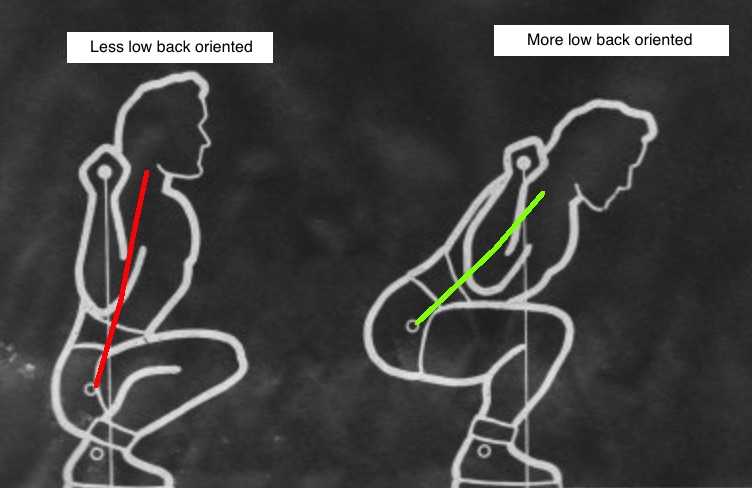There is a fair amount going on here.
First, the notion of a "correct" squat is open to some interpretation. Nobody would say C) is correct, but B) and A) are debatable.
For instance, if your goal while squatting is to hit the quads, then A) is more correct than B). Notice how A) has a greater knee bend. The butt is closer to the heels:

If your goal is to hit the posterior chain (low back, glutes, hamstrings), then B) is more correct. Notice how much more vertical the torso is in A). In a squat, your low back doesn't get much work if it's not moving!

Similarly, if your goal is to lift the most amount of weight, then you typically want to go with the trunk-more-leaned-forward approach, as it involves more muscle mass = greater lifting ability.
This is why people can back squat more than they can front squat. A front squat is more upright, thus more quad dominant and less posterior chain dominant. Furthermore, it's hard to lean forward in a front squat- you'll lose the bar!

Credit: Starting Strength.
I've been using green and red lines for good and bad, but note how this could all be reversed.
- For someone with knee pain history, a squat with more knee bend may be less correct for them.
- For someone with a low back pain history, a squat with more trunk flexion may be less correct for them.
Structure
Injury history is one way of individualizing the squat. A lesser appreciated element is bone variation.
Perhaps most well known is lever lengths. Notice the difference:

When you have long femurs relative to your torso, it's harder to stay upright. Those femurs push your hips back as you go down. Leaning the torso forward is an understandable compensation: if you try to stay upright, you're much more likely to fall backwards.
This is a big reason olympic weightlifters have short legs relative to their torso. Yes, short legs means not having to move the bar as far, but it also means an easier time staying upright. (Remember, if you fall forward in a front squat -which is the position of the catch in a clean and jerk- you're much more likely to dump the bar.)
We can take this further. Notice how the more low back oriented squat involves more hip flexion. The knees are more into the chest:

(This is especially true if depth is kept constant. Notice how the right image is not squatting as deep. If you squat the same depth and allow more trunk flexion, you get the trunk even closer to the knees.)
Well, just like not everybody can do a split, not everybody can bend their hips the same
For example, if a person has a deep hip socket, the head of thigh bone will hit the hip bone sooner:

This is one version of femoral acetabular impingement (FAI). If someone is getting pain in the front of the hip while squatting, such as a pinching, this is typically the cause. Often, they are running out of room. The bones are colliding.
Conversely, shallow hip sockets means it's easier to squat deeper / bend your hips. Ballet dancers are notorious for shallow hip sockets. But...more mobility isn't always a good thing! Ballet dancers are notorious for hip dysplasia. Or think about someone with chronic shoulder dislocations. When the joint isn't as snug in the socket, it's more mobile.
There is even more to consider. The more upright squat necessitates more ankle flexibility as well.


This is also why olympic weightlifters will wear shoes with big heel lifts. By elevating the heel relative to the toes, you plantarflex the ankle. Thus, you now have more room to dorsiflex before hitting your terminal ankle range of motion. Just like the hips, try to dorsiflex the ankles too much, and you'll start feeling a blocking or pinching, from the bones banging into one another.
However, the hips tend to be the primary concern when addressing "correct" squatting. Here's more info on how they can vary person to person:
Hip retroversion- We've only been talking forward and backward motion. This deals with rotation.
Hip adaptation limitations- This is a big one. The first reaction to this kind of information is always "Ok, how do I change this? What do I stretch?" The point here though is this is structural. Much like our height, once it's set, bone doesn't really change orientation.
Understanding trade offs- How these structures can be beneficial.








